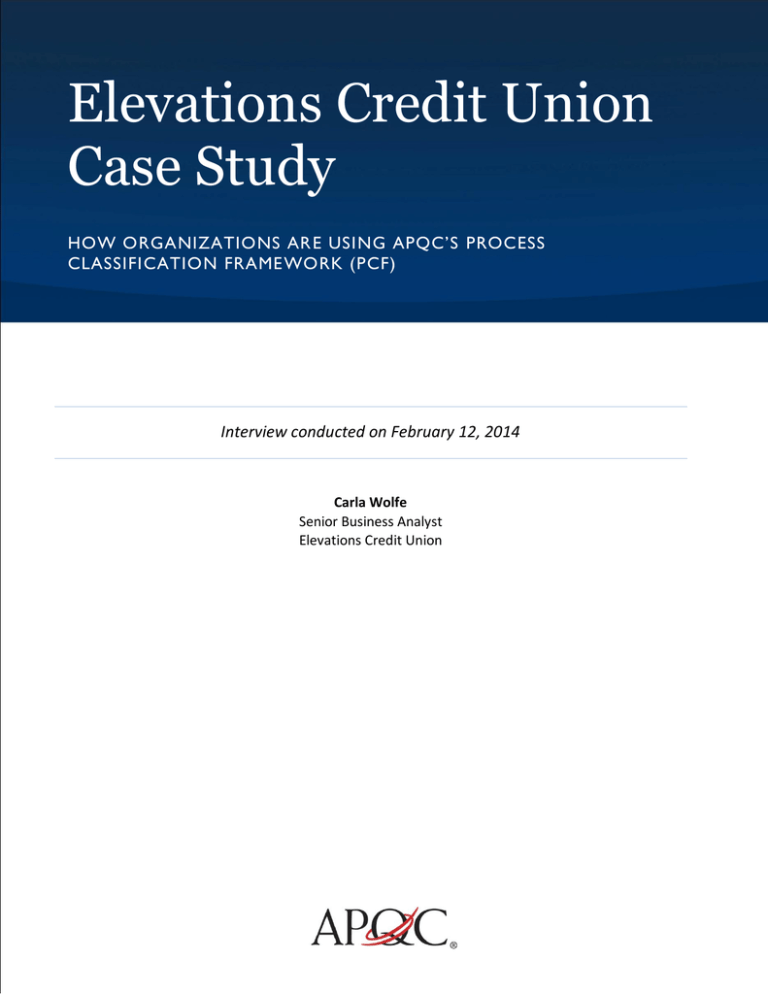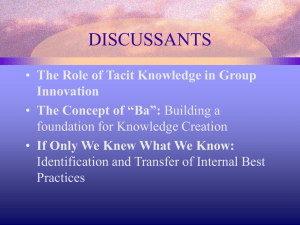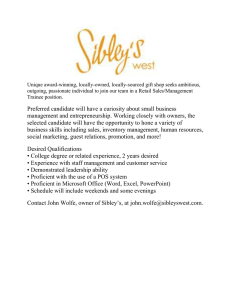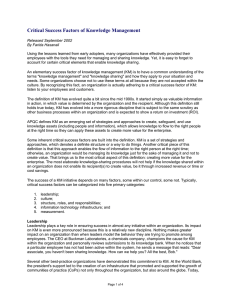
Elevations Credit Union
Case Study
HOW ORGANIZATIONS AR E USING APQC’S PROCESS
CLASSIFICATION FRAME WORK (PCF)
((
Interview conducted on February 12, 2014
Carla Wolfe
Senior Business Analyst
Elevations Credit Union
“The PCF and the subsequent process transformation fundamentally
changed who we are. It rewired us. It changed our DNA. We are now better
at everything we do.”
—Carla Wolfe, Senior Business Analyst
Organizational Background
Elevations Credit Union is one of the largest credit unions in Colorado. Founded in 1952, it has
experienced tremendous growth in the last few years.
Between 2009 and 2012:assets under management climbed 37 percent, from $937 million to
$1.3 billion;
total deposits ascended 34 percent, from $856 million to $1.1 billion;
total members increased by 23 percent, from just over 80,000 members to almost 100,000.
The growth is attributable to a number of efforts, most notably the process improvements
spearheaded by CEO Gerry Agnes.
Striving for Performance Improvement
In 2008, the then-newly hired CEO sought ways to make Elevations Credit Union transform into
a more efficient organization. At the time, “we had no structured business models,” says Carla
Wolfe, Elevations’ senior business analyst. Employees had worked at the credit union for years
and most of the knowledge was tribal. “To solve [daily] problems, folks would move from one
desk to another. We got our work done as a result of random acts of goodwill.”
Seeing opportunities for growth, and concerned that the ad hoc patchwork approach to process
would limit that potential, Agnes determined that Elevations had a “big, hairy, audacious goal”
(BHAG) to adopt the Baldrige Criteria for Performance Excellence and win the Baldrige Award.
The Baldrige Program, established in 1987 with the help of APQC founder Jack Grayson, helps
organizations assess and improve their overall performance management efforts. The Baldrige
Program seeks to identify organizations whose processes can serve as role models for others. As
a foundational step in adopting a process mindset, Elevations was exposed to APQC’s Process
Classification Framework.
Page 2 of 13
Research provided by APQC, the international
resource for benchmarks and best practices
K04951
©2014 APQC. ALL RIGHTS RESERVED
WHAT IS THE PROCESS CLASS IFICATION FRAMEWORK?
The PCF is a list of activities organizations use to articulate work processes. By using a common
language to define all the tasks inside of an organization, the framework standardizes an
approach to a number of crucial needs, such as: process management, benchmarking and
content management.
Without such a pre-defined list, multiple business units within a single organization could have
duplicative interpretations of even the most basic processes, such as invoicing. Redundancies
lead to varying definitions for the underlying measures, such as "inventory management.” This,
in turn, can undermine any ability to manage a process consistently across an enterprise.
“Despite a couple decades in consulting, I had no exposure to the PCF. But when I saw it, it blew
my socks off,” Wolfe says. “I was simultaneously being introduced to the Baldrige model and it
was a combined power punch. Baldrige is all about identifying what your key process are, as well
as how you implement and integrate it. And that’s what the PCF is built on.”
The combination of the Baldrige and the PCF opened employees’ eyes to what was missing at
the credit union. The existing procedures lacked ownership and governance and most of the
way the organization did business was based on employee knowledge and emails. “We had
outgrown what we had,” says Wolfe, “but didn’t recognize how big the gaps were.”
Wolfe and the enterprise performance group at Elevations Credit Union engaged in a five year
process journey (Figure 1) to address the lack of process and embed a process oriented culture
within the organization.
Page 3 of 13
Research provided by APQC, the international
resource for benchmarks and best practices
K04951
©2014 APQC. ALL RIGHTS RESERVED
Elevations Credit Unions Five-Year Process Journey
Figure 1
YEAR ONE: DEVELOP AN INITIAL ENTERPRISE PROCESS M AP
FRAMEWORK
To initiate its journey, Wolfe and the enterprise performance group needed to understand the
current state of Elevations processes and documentation, identify the gaps, and start developing
a plan.
Creating a Process Baseline
To better understand the current state of Elevations Credit Union’s processes and
documentation, Wolfe took each task and activity within APQC’s Banking PCF and turned it into
a survey, asking employees to state whether the activity or task is performed and, where
applicable, if documentation exists. Wolfe stressed the importance of keeping the survey simple
and engaging, so she combined a simple rating system (Figure 2) with function-specific lists of
processes.
Page 4 of 13
Research provided by APQC, the international
resource for benchmarks and best practices
K04951
©2014 APQC. ALL RIGHTS RESERVED
Survey Process Rating System
Figure 2
The survey uncovered that 86 percent of the organization did not have, or could not readily
document, basic processes. “Only payroll scored a one,” says Wolfe. “We started with a deep
hole.”
Establishing a Process Group-Level Framework
Common practice states that, when conducting an enterprise-wide change, one should start
simple and only prioritize a few activities for improvement. Elevations Credit Union did not have
the luxury of taking several years to build its process infrastructure Hence it didn’t have the time
to build all of its process from the ground up and used the findings of the survey to identify what
elements of the Banking PCF would become the organization’s initial process group-level
framework.
Simply having a process framework isn’t enough; getting employees to really embrace the
change is crucial. To begin establishing employee buy-in, Wolfe used a series of workshops, for
each process groups, to document the flow of processes. She enlarged the PCF sections until
they were wall-sized and used post-it notes to identify the “state” of each process (illustrated in
Figure 3) based on the survey results. The color of the post-it notes corresponded to the rating
system in Figure 2, so employees could see the process gaps.
Page 5 of 13
Research provided by APQC, the international
resource for benchmarks and best practices
K04951
©2014 APQC. ALL RIGHTS RESERVED
Survey Results and the Enterprise Process Map
Figure 3
Through facilitated sessions, process owners and key process stakeholders used customer-based
scenarios to connect sub-processes across the enterprise. Sometimes, an actual string was used
to trace the linking sub-processes. For example, how the credit union attracts a new member.
Marketing might send a coupon to a member prospect; customer service would welcome him
into the facility, and then hand him off to a teller to assist in opening an account, and so on.
This exercise accomplished three things. First it pinpointed which process-groups were intrinsic
to the customer value and which ones were the least developed; providing information for
future process development prioritization. Second it created an initial framework for the
Enterprise Process Map. Finally, it helped the organization realize how all the processes were
linked and gain understanding one group’s outputs are another’s inputs.
Building the Processes
Once employees understood how everyone, in every process, was connected, the core process
teams began building SIPOCs—a technique that requires the identification of all of the suppliers,
inputs, processes, outputs, and customers for each task. SIPOCs crystalized the idea that “my
outputs are someone else’s inputs and vice versa,” said Wolfe. SIPOC is now a requirement for
the process development efforts and is essential for process stakeholder engagement because
it:
links processes across the enterprise process map, and
provides initial orientation for building processes and training for employees.
Page 6 of 13
Research provided by APQC, the international
resource for benchmarks and best practices
K04951
©2014 APQC. ALL RIGHTS RESERVED
YEAR TWO: ESTABLISHING CONSISTENCY ACROSS THE
ORGANIZATION
By year two Wolfe and the enterprise performance group had to shift from driving the business
process development to governing the approach. This meant they had to build the tools and
support materials the rest of the organization and the core process teams would need to take
ownership of further development and documentation efforts.
Establishing a Standardized Tool
First Wolfe and her team entered the Banking PCF and initial process frameworks developed by
the core teams into a business process mapping (BPM) tracking tool (Figure 4). The tool used
scorecards to assess the status of each project and provided senior leadership with data on
process development and improvement efforts. Furthermore the tool:
incorporated the SIPOC methodology,
identified and tracked process owners and stakeholders,
provided easy access to multiple process owners, and
reinforced a standard methodology and tracking process.
BPM Tracking Tool
Figure 4
Providing Training and Support Materials
In addition to a standardized tracking tool, Wolfe and team conducted training on its business
process development methodology and created a BPM Workbook—a step-by-step manual on
process development and management. The work book is a 47 page document that enables selfdirected process development, is pre-requisite reading for training classes, and encourages
employees to train and lead process development and management within their teams. The
workbook includes chapters—full of examples, templates, and advice—on:
1. Building a process—from identifying a process need to creating a process flow chart
Page 7 of 13
Research provided by APQC, the international
resource for benchmarks and best practices
K04951
©2014 APQC. ALL RIGHTS RESERVED
2. Measuring and improving a process—from selecting the appropriate metrics to managing a
process improvement project
3. Business process management tools—outlines how to use Elevation’s process tools (BPM
Tracker and BlueworksLive)
4. Writing a procedure—step-by-step instructions on how to go from a process to desk-level
instructions and content
YEAR THREE: CONNECTING THE DOTS TO FOSTER ADOPTION
By year three, Wolfe and team began to see results. Process standardization was starting to
become a part of the culture and led to the ability to conduct, review, and manage using applesto-apples benchmarking.
At this time Elevations needed additional functionality out of its business process tracking tools.
As process development was improving and began to span across functions, Elevations needed
the ability to:
exponentially increase the velocity of its BPM development efforts;
establish a single source of information for all things process;
provide reporting, sorting, scouting, and coaching;
enable many teams and departments to contribute and get engaged; and
support the printing of flowcharts and working laboratories and Value Stream
conversations on walls/halls.
There are many tools out there that will accomplish these goals, Elevations decided to use IBM’s
BlueworksLive because it enables governance by Wolfe and team, provides collaboration
between all stakeholders, links processes to each other and to project management, and
includes dashboards for decision making.
YEAR FOUR: USING PROCESS IMPROVEMENT TRANS PARENCY TO
ENGAGE THE ORGANIZAT ION
For example, Elevations used its success in transforming its lending and underwriting process by
publicly displaying its results to engage employees for further process development. This
inspired the owners of the linking processes to publish their processes and gave visibility to
inputs and outputs from one process to the next. To educate the rest of the business on the
lending and underwriting process, maps are posted on a wall and the leading officer walks
groups of employees through the process steps over and over. The maps now stretch across an
entire hallway and have led other teams to do the same thing.
Now, the consumer lending process is fully documented, starting from when the member walks
through the door requesting a loan until Elevations receives the first month’s payment. The
Page 8 of 13
Research provided by APQC, the international
resource for benchmarks and best practices
K04951
©2014 APQC. ALL RIGHTS RESERVED
documented processes have linking inputs, outputs and shared metrics. “It’s amazing how much
we’ve been able to reduce risk and cycle time,” says Wolfe. “We have also gained tremendous
insight on how to better serve our membership.”
Employees began responding to the improved transparency and employee engagement scores
increased significantly. “When someone gets it, it just clicks. The lights go on for them. And we
started leveraging these people to share their understanding with others.”
These advocates—dubbed “special forces”— are grassroots process authorities who have been
given additional training on the BPM tools and processes. Elevations has identified 21 special
forces who are typically managers, representing every functional area—who are now
responsible for providing oversight and coaching on process development. The special forces
are involved with every process development project and:
assist in the design and deployment of functional area processes which are linked and
integrated with other functional areas and stakeholders;
ensure consistency and completeness among users of BlueworksLive for capturing process
documentation including SIPOCs and flowcharts by implementing BPM methodology, rules
and guidelines; and
collaborate and advise on defining, designing, deploying, and monitoring a process.
The use of advocates has improved the level of engagement and generated widespread buy-in
on the value of processes. “When we started, no one knew what we were talking about,” says
Wolfe. “Now, there isn’t anyone in the organization who doesn’t know the value of our
processes.”
YEAR FIVE: MAKING IT S TICK
By 2013, Elevations had process development projects in every aspect of the business ranging
from process improvement efforts for previously established processes to initial process
development efforts. Now that the organization has momentum and has matured in its processoriented perspective, Wolfe and team moved onto the next stage—making it stick. To
accomplish this, Wolfe and team developed additional programs, tools, and support materials.
Opportunity for Improvement Games
Wolfe and team wanted to start getting the organization engaged with the idea of process
improvement. They developed the “opportunity for improvement” (OFI) games. For these
games, the special forces and Wolfe’s team would conduct “ride-alongs” while people
performed their job to identify and note a list of process improvement opportunities. They then
worked collaboratively to develop a prioritized, cross-functional list of improvement initiatives.
Each functional area adopted a board game appropriately aligned with their work and created a
wall chart to track their progress. For example, human resources had “Chutes and Ladders,”
Page 9 of 13
Research provided by APQC, the international
resource for benchmarks and best practices
K04951
©2014 APQC. ALL RIGHTS RESERVED
operations used “Monoperations”, and lending used “CandyLand.” The game board serves two
purposes. First, it provides transparency on the OFIs for the organization. Second it enables the
team to track progress for “knocking OFIs off the list” using public recognition to reinforce
desired behaviors.
Enterprise Dashboards
As the organization’s processes and measures grew in complexity and leadership’s need for data
to support its decision making also expanded, Elevations implemented an enterprise dashboard
system (Figure 5) that provide access to the organizations KPIs (actual, target, and variance).
There is a corresponding “drill down” dashboard for each category of the PCF in the enterprise
process map.
Enterprise Dashboards
Figure 5
“The ability to get real in-process metrics was a fundamental change in how we operated.”
Wolfe says. “We all remember the first time someone could stand up and talk solidly from
numbers. Others looked around the room and asked ‘How is she doing that?’”
From that moment on, senior leaders began managing via enterprise dashboards. If the
organization is not moving in the right direction, it is now clear what to do. “All of our metrics
are tied back to processes, so, by tracing back to the source of the problem, we can now figure
out what’s broken and why,” Wolfe says.
Page 10 of 13
Research provided by APQC, the international
resource for benchmarks and best practices
K04951
©2014 APQC. ALL RIGHTS RESERVED
Governance of Knowledge Assets
Finally to ensure standardization of its language, processes, and policies, Wolfe and team
developed the “knowledge assets governance” (Figure 6). This structure created a framework of
Elevations’ operating and business rules and definitions, including:
board of directors policy;
management policies;
business process and procedures;
business rules; and
its forms, notices, disclosures and letters.
Knowledge assets are submitted through a governance process in which assets are reviewed
and validated using the BPM methodology which ensures stakeholder review and approval. All
of these assets are made available in an enterprise-wide reference desk.
Knowledge Assets Governance
Policy
Rules
Definitions
Process
Procedure
Formsdisclosures
Figure 6
The Payoff
Using these techniques, Elevations has now mapped more than 261 processes. All are linked to
the PCF and documented all the way down to desk-level procedures. “The PCF is now a language
everyone speaks,” Wolfe says. Elevations’ use of the Banking PCF saved the organization time
Page 11 of 13
Research provided by APQC, the international
resource for benchmarks and best practices
K04951
©2014 APQC. ALL RIGHTS RESERVED
because it provided an overarching architecture to organize, align, and integrate our processes.”
These performance improvement efforts have enabled Elevations to make data-driven
decisions, match the right skills to each process, and eliminate redundancies. Furthermore its
combination of people, process, and tools has provided process improvements (Figure 7),
financial benefits, and external recognitions.
Elevations Process Improvements
Activity
Before Process
Development
After Process
Development
10–13 days
4–5 days
Home Equity loans funding
cycle time
30 days
14–15 days
Average number of consumer
loans per month
483
659
Vehicle loans cycle time
Figure 7
Elevations’ transformation to a process-oriented culture has contributed to tripled earnings and
35 percent increase in membership, as well as an increase in its equity by 97 percent. Elevations
was the 2013 Rocky Mountain Performance Excellence PEAK award winner and is a
2014 applicant for the National Malcolm Baldrige Performance Excellence Award.
Page 12 of 13
Research provided by APQC, the international
resource for benchmarks and best practices
K04951
©2014 APQC. ALL RIGHTS RESERVED
Page 13 of 13
Research provided by APQC, the international
resource for benchmarks and best practices
K04951
©2014 APQC. ALL RIGHTS RESERVED



